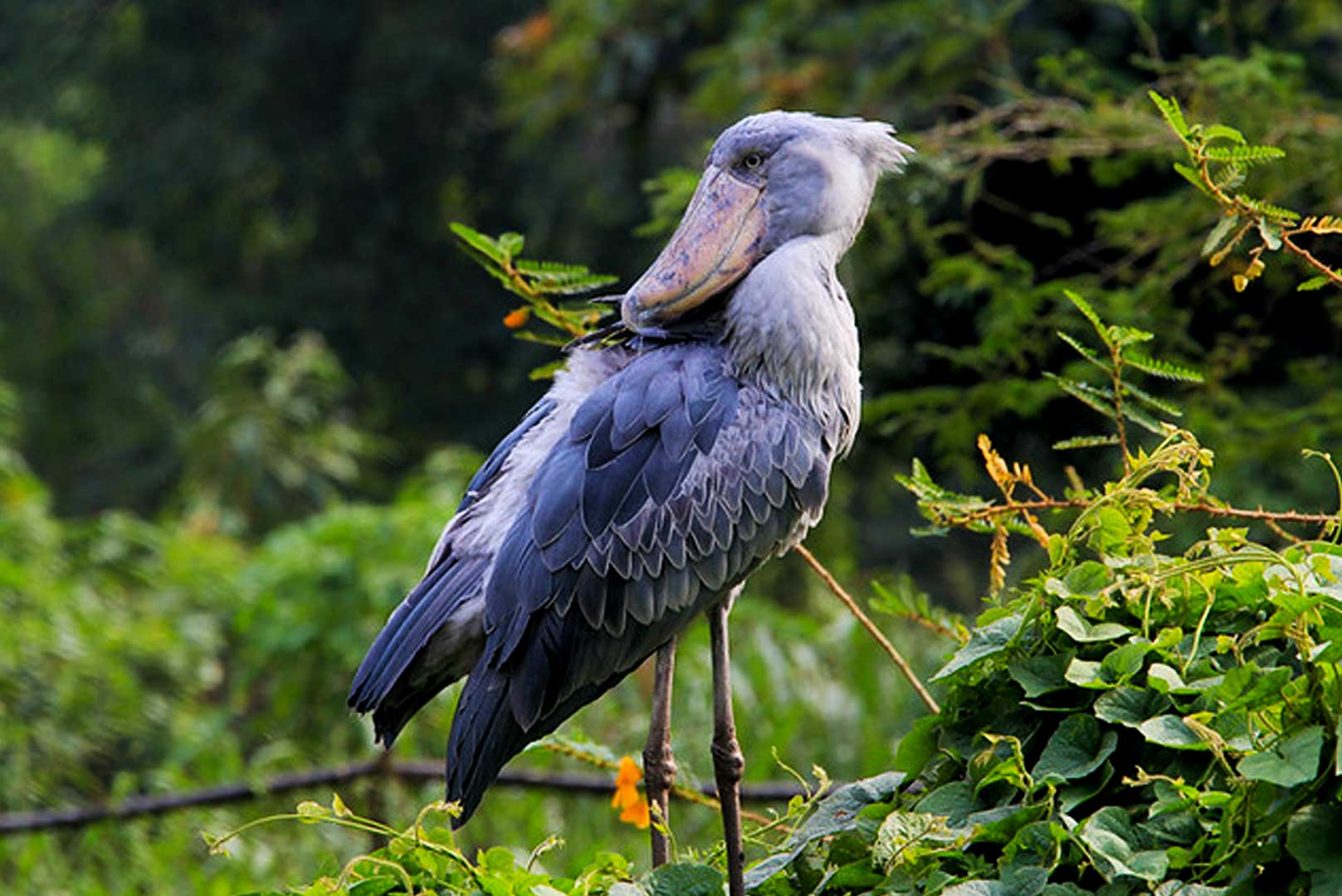Table of Contents
6 Best Places To See Shoebills In Rwanda
Here are the 6 best places to to see shoebill in Rwanda and they include Akagera national park, Nyabarongo wetlands, Rugezi Marsh, Lake Rweru, Lake Mugesera and Cyamudongo Forest.
Rwanda is a captivating country known for its stunning landscapes including rolling hills and wildlife like mountain gorillas. When you visit Rwanda, you can expect to see clean streets, well-maintained parks and a general sense of cleanliness throughout the country. Rwanda is considered to be a birder’s heaven with over 703 bird species including the majestic Shoebills.
Shoe bills are known for their huge, unique beak and stern temperament, the shoebill is a prehistoric-looking bird that is one of the most sought-after sightings in Rwanda. The shoebill, despite its intimidating look, is extremely hard to spot favoring the isolated wetlands and papyrus swamps that are scattered across Rwanda.
Let’s explore the 6 best places to see shoebills in Rwanda
1. Akagera National Park In Rwanda
Akagera National Park is one of the 6 best places to see shoebills in Rwanda. This park is located near the Tanzanian border, a symbol of the nation’s dedication to biodiversity and conservation. The oldest national park in Rwanda, Akagera was created in 1934 and spans a vast area of over 1,122 square kilometers.
One of its highlights is the elusive shoebill, often spotted in specific areas like Lake Ihema and the Akagera River Delta, where boat safaris offer close encounters. Papyrus swamps throughout the park also provide ideal habitats for shoebills, offering visitors immersive wildlife experiences in this biodiverse haven.
Apart from the shoebill in Akagera National Park, there are other activities that can be done in Akagera national park include fishing, guided nature walks, birdwatching of over 550 bird species, the big five African mammals which include elephants, lions, leopards, buffaloes as well as rhinos can also be spotted in Akagera National park.
2. Nyabarongo Wetlands In Rwanda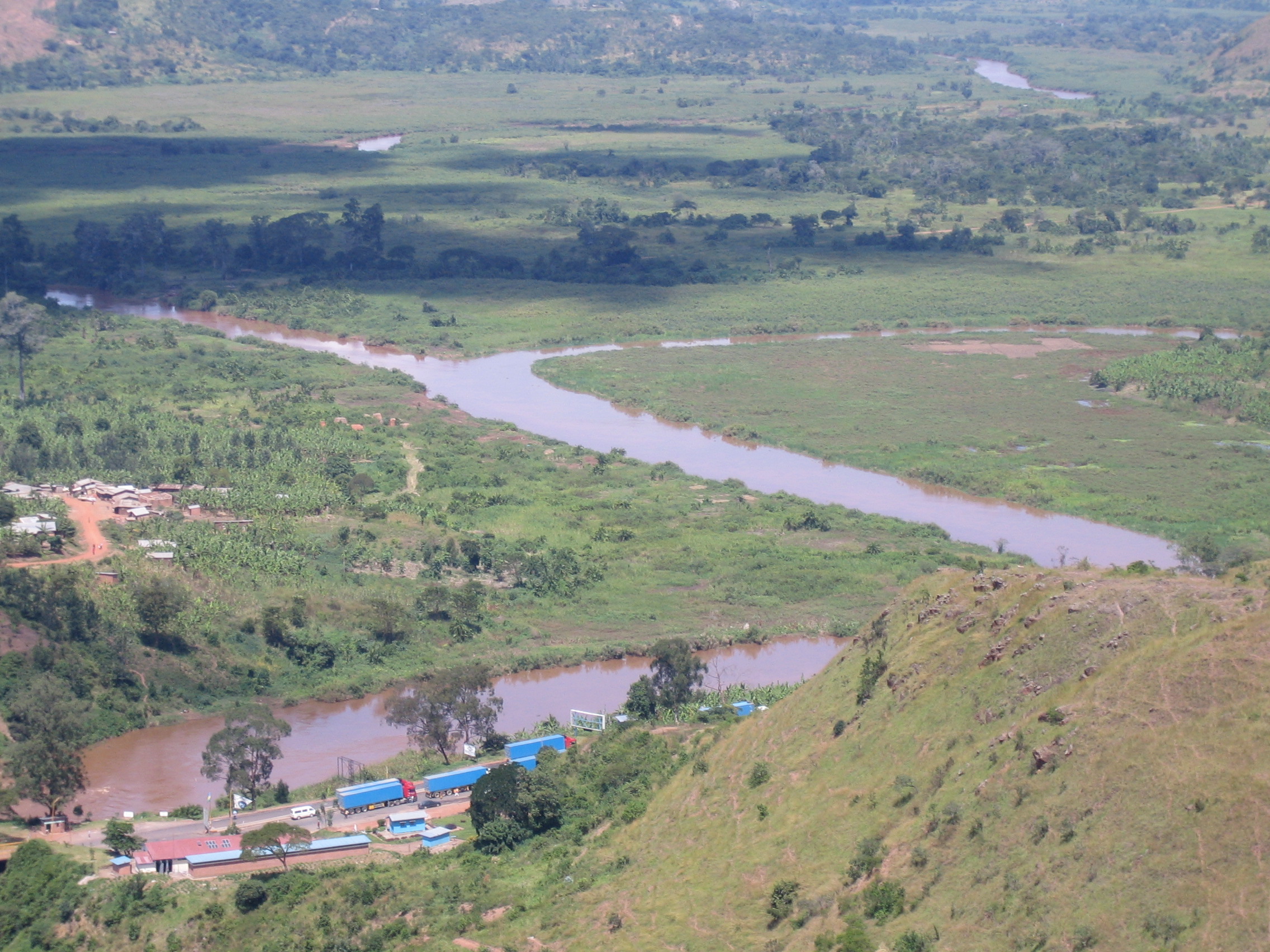
Nyabarongo wetlands is also one of the 6 best places to see shoebills in Rwanda. It is located in the central region of Rwanda, the expansive Nyabarongo Wetlands comprise of an interconnected system of marshes, swamps, and rivers that are provide as vital habitat for numerous bird species, among them the elusive shoebill.
These wetlands are located along the Nyabarongo River, which is Rwanda’s largest river. Birdwatchers are able to observe shoebills foraging in the rich foliage and shallow waters as they pass through these areas. Experience this biodiverse ecosystem while exploring the river on guided boat tours; while looking out for sightings of shoebills and other avian riches.
3. Rugezi Marsh In Rwanda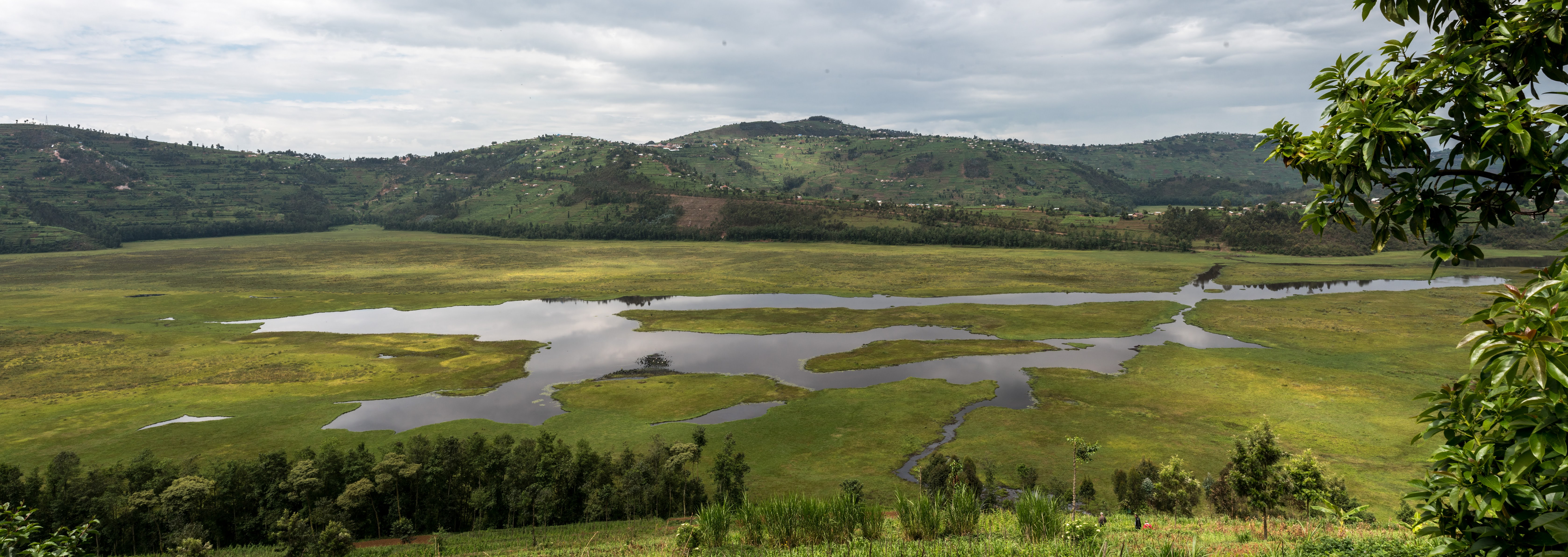
Rugezi Marsh is also one of the 6 best places to see shoebills in Rwanda. It is a serene haven known for its visual beauty and abundant wildlife. It is tucked away in the lovely hills of Northern Rwanda. Equipped with vital habitat for numerous bird species, including shoebills, these vast marshes are fed by the waters of the Muvumba River.
Sneak peeks of shoebills among the reed beds and peaceful waterways can be done by guests on guided birdwatching walks through Rugezi Marsh’s meandering channels and immaculate wetlands. Rugezi Marsh provides birdwatchers hoping to witness Rwanda’s recognizable shoebills with a tranquil haven due to its placid atmosphere and breathtaking natural landscape.
Other bird species that can be spotted in Rugezi marsh include, Grauer’s swamp warblers, Papyrus gonolek, Grey-crowned cranes, Thick-billed seed eaters, Carruthers’s cisticola, Papyrus canary.
4. Lake Rweru In Rwanda
Lake Rweru is also one of the 6 best places to see shoebills in Rwanda. It is a scenic lake in Eastern Rwanda well-known for its diverse birdlife, which includes sightings of the rare shoebill. The lake is a popular spot for wildlife enthusiasts and birdwatchers because the marshes around it serve as vital habitat for many different bird species.
Guided boat tours provide visitors to Lake Rweru with an opportunity to see shoebills and other water birds in their native habitat. In the eastern part of Rwanda, Lake Rweru provides an unforgettable shoebill-spotting experience with its stunning scenery and plethora of wildlife.
While at Lake Rweru, you can engage in a variety of activities, like birdwatching, swimming, fishing, kayaking and also boat rides.
5. Lake Mugesera In Rwanda
Lake Mugesera is also one of the 6 best places to see shoebills in Rwanda. It is nestled in southeastern Rwanda which offers a promising opportunity for shoebill sightings. With its tranquil waters and lush wetlands, the lake provides an ideal habitat for these elusive birds.
Visitors can join guided boat tours to explore the area, increasing their chances of spotting shoebills amidst the diverse birdlife. While sightings are never guaranteed, Lake Mugesera’s serene setting and abundant wildlife make it a captivating destination for birdwatching enthusiasts seeking encounters with these iconic avian species.
Lake Mugesera is home to a variety of bird species besides the shoebill and they include Pied kingfishers, the African fish eagle, malachite kingfishers, great white pelican and African jacana.
6. Cyamudongo Forest In Rwanda
Cyamudongo Forest is also one of the 6 best places to see the shoebills in Rwanda. It is tucked away in southeast Rwanda, a biodiverse paradise just waiting to be discovered. A variety of species, including the elusive shoebill, find refuge in this hidden gem with its towering trees, twisting streams, and rich foliage.
With the opportunity to see these magnificent birds up close and personal with Rwanda’s natural splendor, guided nature walks let guests to experience the peace and quiet of the bush with the melodious sounds of the birds resonating through the canopy.
Visitors can discover the rich flora and fauna by taking guided nature trips at Rwanda’s Cyamudongo Forest. Opportunities for photography, primate tracking, and birdwatching abound. while informative trips offer insights into conservation initiatives. Relaxation and cultural immersion are provided by picnicking and village visits, guaranteeing a unique experience in this biodiverse setting.
The Best Time To See Shoebills In Rwanda
The Best time to see shoebills in Rwanda is during the dry season, which runs from June to September. It is easier to see these elusive birds during this time of the year due to the decreased water levels in marshy places such as Akagera National Park. Reduced foliage improves visibility, making it more likely that you may see shoebills as they search for fish and other prey.
Other Birds That Can Be Seen In Rwanda
Rwanda is home to a diverse range of bird species
Grey Crowned Crane: The graceful Grey Crowned Crane is recognized as Rwanda’s national bird and is a classic representation of beauty and grace. This magnificent bird, which has remarkable plumage and a brilliant golden crown of feathers, is frequently seen in Rwanda’s grasslands and wetlands, where it deftly forages for food and engages in mesmerizing mating dances.
Rwenzori Turaco: Rwanda’s highland woods are enriched with color thanks to the Rwenzori Turaco, which has vivid scarlet and emerald green plumage. This amazing bird which is native to the Albertine Rift, is frequently observed flying over the canopy and making melodic notes that reverberate through the mist-covered mountain.
African Fish Eagle: The magnificent African Fish Eagle, a representation of strength and independence is frequently spotted close to Rwanda’s rivers and lakes. This magnificent raptor, with its distinctive white head and sharp yellow eyes, is often spotted soaring overhead or perched on a high overlook, constantly on the lookout for its next meal.
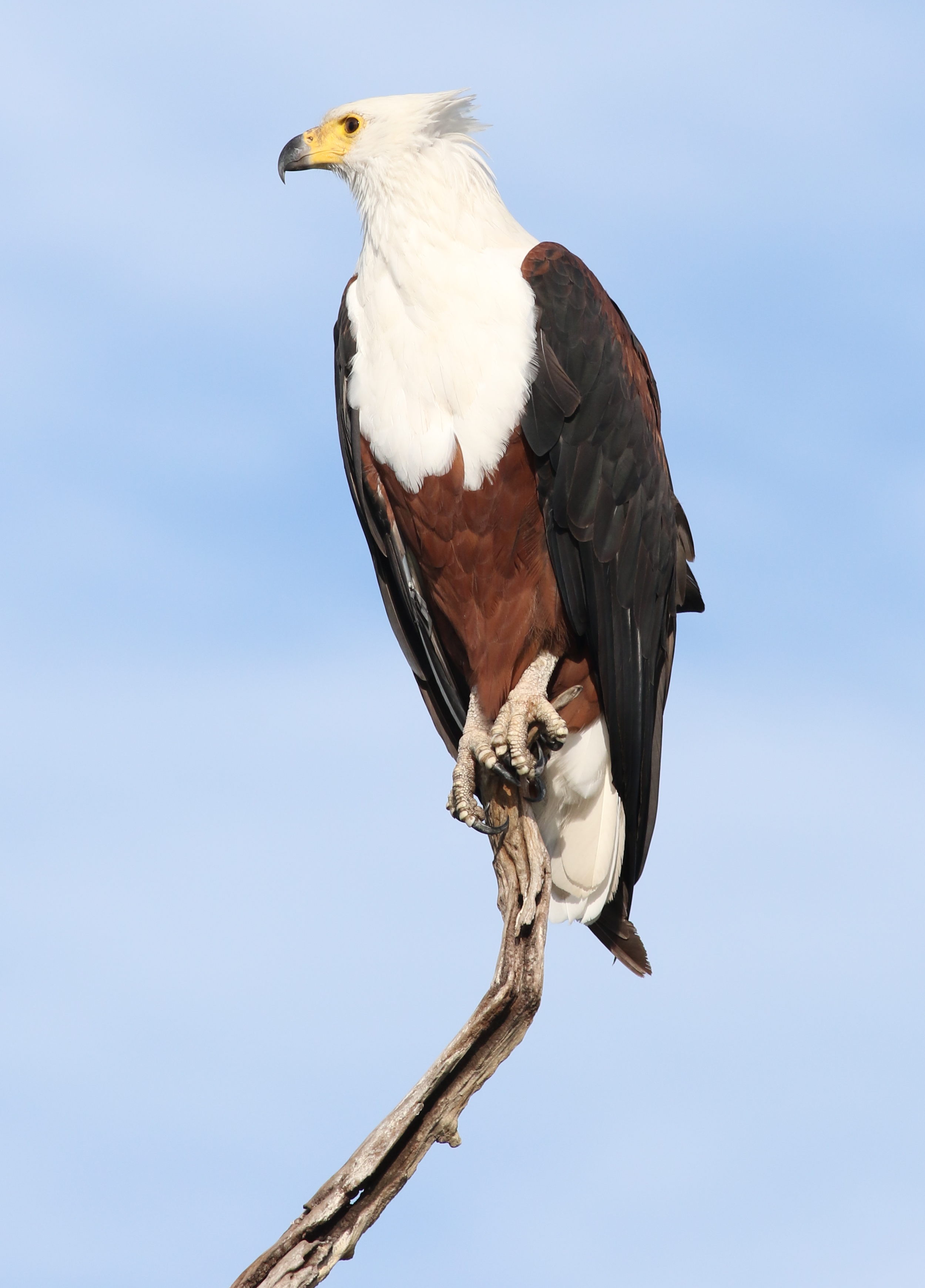
African Green Pigeon: The African Green Pigeon, with its vivid green plumage and a white eye-ring , is a sight to behold, adding a splash of emerald to Rwanda’s woods and woodlands. These arboreal birds, which are frequently observed in small flocks and eat on fruits and seeds add a peaceful element to Rwanda’s lush surroundings as they gracefully soar through the canopy.

Rwenzori Batis: The Rwenzori Batis, a tiny, insectivorous bird native to the Albertine Rift region, is easily recognized by its striking yellow eye and vivid black-and-white plumage. These nimble birds, which are found in Rwanda’s steep montane forests, dart between the trees as they hunt insects with dexterity and grace, enhancing the beauty of the country’s verdant forests.
Pied kingfishers: Pied Kingfishers are a regular sight along the shores of Lake Mugesera in Rwanda. They are easily identified by their distinctive crest and black and white plumage. These nimble hunters show off their incredible fishing skills by hovering over the water and then precisely diving in to catch fish.
Experiences with Pied Kingfishers are wonderful for tourists experiencing the beautiful grandeur of Lake Mugesera, as their exquisite flight and distinctive calls enhance the charm of seeing them as they dart across the lake’s surface.
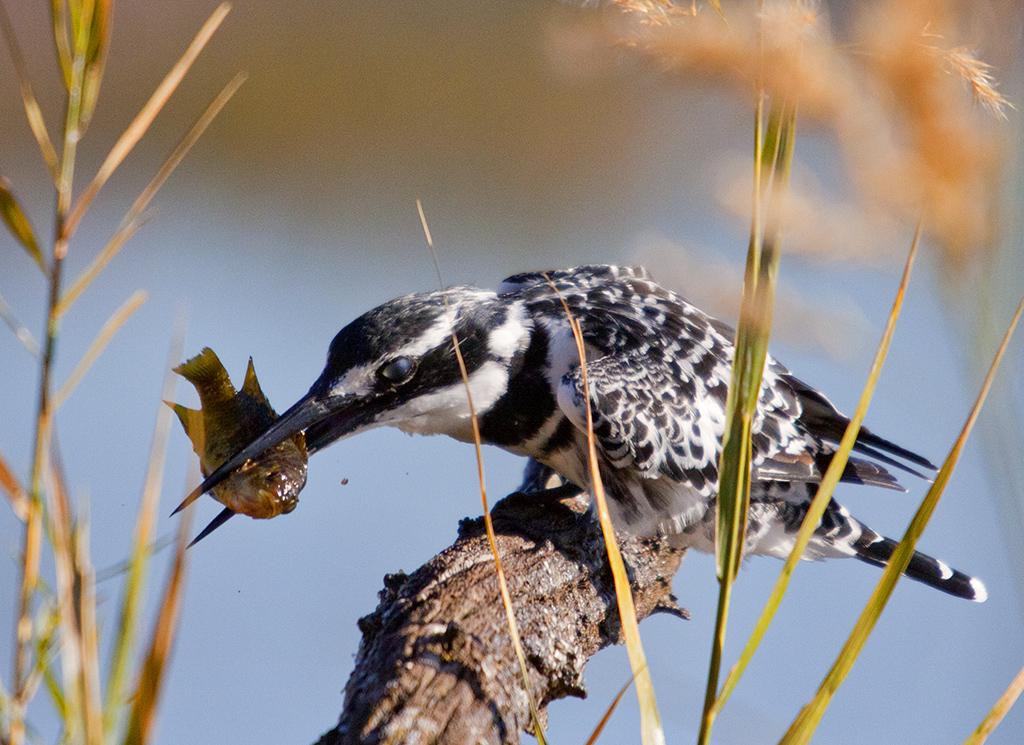
Great White Pelican: On Lake Mugesera in Rwanda, the Great White Pelican is a magnificent sight with its enormous wingspan and striking white plumage. These pelicans which are frequently spotted in big groups, glide across the placid waters with exquisite grace while precisely diving to capture fish.
For birdwatchers and environment lovers, seeing these amazing birds in the beautiful surroundings of Lake Mugesera is even more alluring because of their social activities and aerial shows, which provide unique experiences.
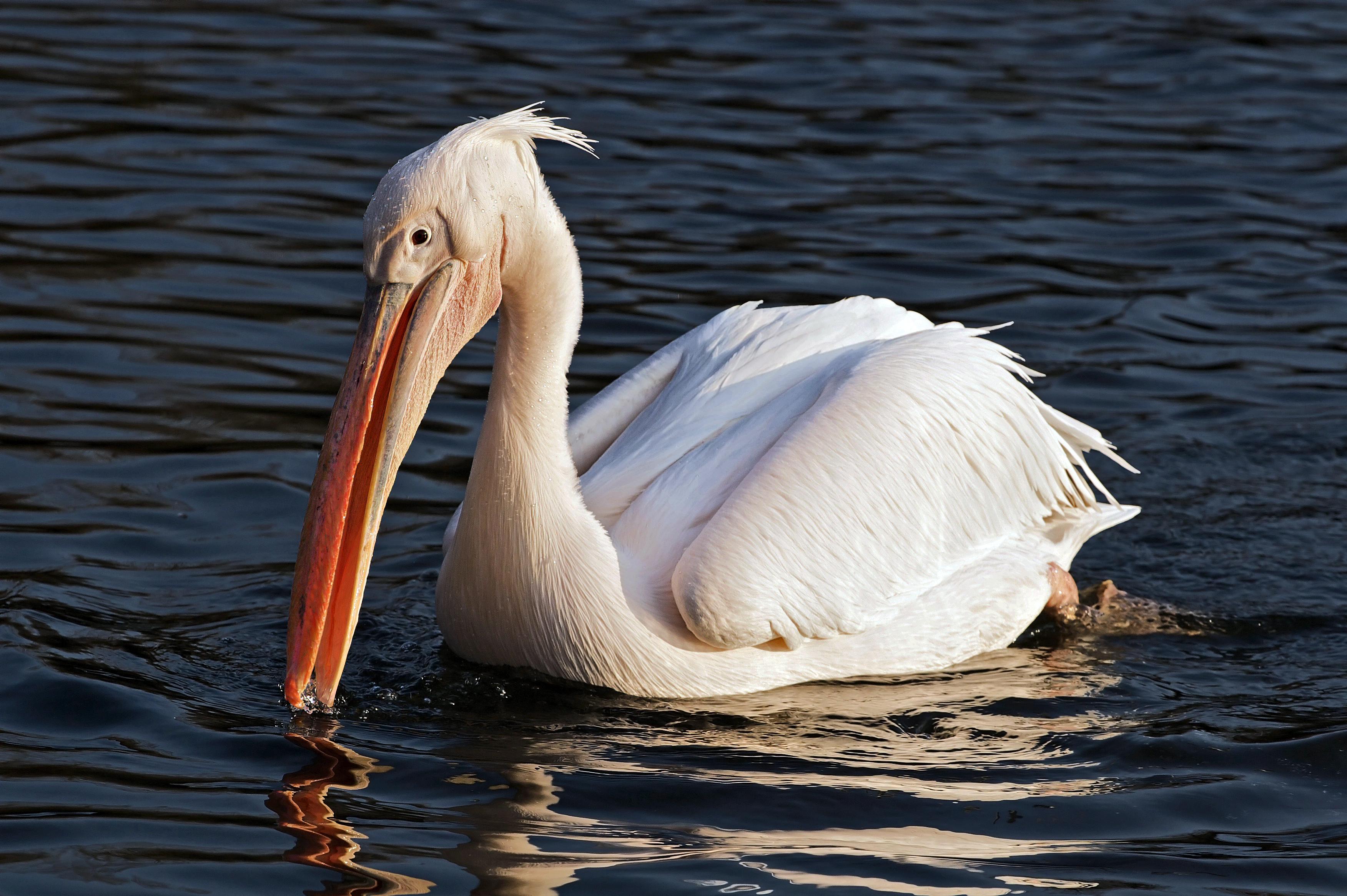
Eastern Double-collared Sunbird: As it flits among flowers in search of nectar, this little sunbird, a sparkling representation of Rwanda’s floral richness, dazzles with its iridescent plumage and quick acrobatics.

Black-headed Heron: This tall, graceful heron, distinguished by its long legs and black crown, is frequently observed scrounging around the shallows of rivers and lakes in search of food.
Across Rwanda, black-headed herons are frequently observed in a variety of habitats, including marshes, rivers, lakes, and even urban areas close to water supplies.

Accommodation Facilities In Rwanda
We will explore the diverse range of accommodation options available across Rwanda, from luxury lodges to cozy guesthouses ensuring every traveler finds their ideal retreat amidst Rwanda’s natural beauty and cultural charm.
Luxury Accommodation
- Bisate Lodge: Nestled within the natural beauty of Volcanoes National Park, Bisate Lodge offers unparalleled luxury in the heart of Rwanda’s wilderness. With its elegantly designed villas boasting panoramic views of the surrounding landscape, Bisate Lodge provides discerning guests with a luxurious base from which to explore the nearby wetlands and forests where shoebills thrive. After a day of adventure, indulge in gourmet dining experiences and unwind in the lodge’s serene surroundings, soaking in the sights and sounds of Rwanda’s natural wonders.
- Ruzizi Tented Lodge: situated on the shores of Lake Ihema, Ruzizi Tented Lodge provides luxury tented accommodation with modern amenities. Guests can relax on private decks, dine on delicious cuisine, and embark on guided safaris in the park.

Mid-range Accommodation
- Kinigi Guesthouse: Situated near Volcanoes National Park, Kinigi Guesthouse provides comfortable and affordable accommodation for travelers seeking a midrange option. Its convenient location offers easy access to shoebill habitats within the park, allowing guests to embark on guided excursions in search of these elusive birds. With cozy rooms, delicious meals, and friendly hospitality, Kinigi Guesthouse provides a welcoming retreat for shoebill enthusiasts looking to immerse themselves in Rwanda’s wilderness without breaking the bank.

Budget-friendly Accommodation
- Shakani Campsite: Ideal for budget travelers, shakani Campsite provides basic camping facilities within Akagera National Park. Visitors can pitch their tents or rent camping equipment and enjoy the tranquility of the park under the starry sky.

Frequently asked questions
- What do shoebills eat?
Shoebills primarily feed on fish like lungfish, but they also consume other aquatic animals like frogs, reptiles and even smaller mammals.
- Why are they called shoebills?
They are called shoebills because of their distinctive bill which resembles an oversized shoe.
- Are shoebills friendly to humans?
They are docile with humans and show no threatening behavior.
- Are shoebills endangered?
Yes, shoebills are considered to be vulnerable to extinction due to habitat loss, hunting, and disturbance of their wetland habitats.
- What is the nickname of the shoebill?
The shoebill is also known as whale head or shoe-billed stork where it derives its name from its massive shoe-shaped bill.
- What countries are shoebills in?
The shoebill is distributed in fresh water swamps of central tropical Africa, from southern Sudan, south Sudan through parts of eastern Congo, Rwanda, Uganda, western Tanzania, and Northern Zambia.
- How long do shoebills live?
A shoebill can leave up to 35 years.
- Where is the best place to see shoebills?
Akagera National Park is one of the best places to see shoebills in Rwanda
Conclusion
I would definitely recommend considering our company for your birding adventure. We have a team of experienced guides at Kubwa Five Safaris who are passionate about wildlife and can provide you with an amazing and personalized experience. Whether it’s spotting shoebills or exploring other bird species, we strive to make your trip unforgettable. So why not choose us for a fantastic birdwatching experience.

